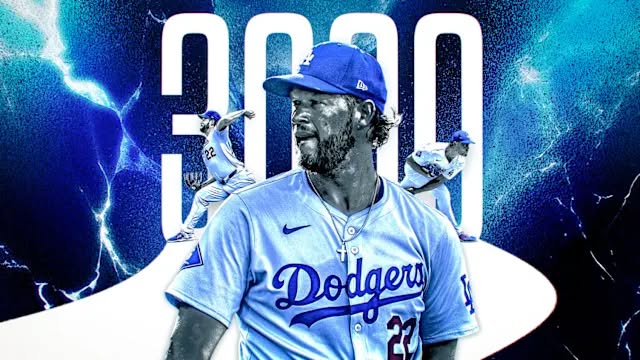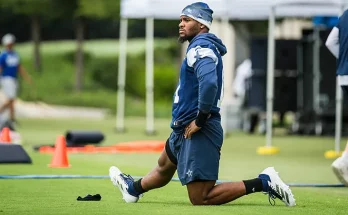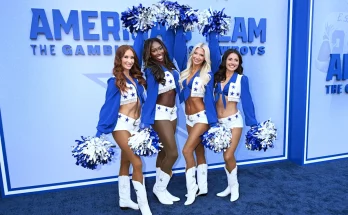Clayton Kershaw has never been one for fanfare. When he first took the mound as a 20-year-old rookie in 2008, he carried with him a quiet confidence that would grow into a legend. Now, 18 seasons later on July 2, 2025, Kershaw etched his name permanently into baseball lore by recording his 3,000th strikeout—a milestone that few have reached and fewer still have achieved with one uniform.
That night, at Dodger Stadium, with more than 53,000 fans on their feet, Kershaw faced Vinny Capra of the Chicago White Sox. He needed just one more punch-out. On a hanging slider, Capra didn’t chase—it was a called third strike, number 3,000, and the roof practically lifted off the ballpark. Dodger Stadium erupted in a roar that mixed relief, jubilation, and emotion. Kershaw paused, doffed his cap to his family in the stands—wife Ellen and their four children—then turned to his teammates with a subtle smile and a nod .
To reach 3,000 put Kershaw among the elite: only the 20th pitcher in Major League Baseball history to do it, joining titans like Nolan Ryan, Randy Johnson, and Walter Johnson . Among active hurlers, he joined Justin Verlander (3,468) and Max Scherzer (3,412), and he became only the fourth left-hander ever to join this elite club. It’s a benchmark that stands not just as a number, but as the mark of an enduring mastery.
To fully appreciate its magnitude, consider that through June 26, 2025, Kershaw had amassed 2,997 strikeouts, just three away, and had done so despite dealing with injuries that would have derailed lesser pitchers . Knee and foot surgeries in the offseason slowed him at times this season, and he began the year on the injured list . But in time, he regained his groove. By his ninth start of the season, he sat at 4–0 with a sterling 3.03 ERA, anchoring a Dodgers rotation ravaged by injuries.
That first strikeout of the season came on his re-emergence from the IL: Kershaw had struggled, giving up five runs in four innings in his first outing back, but then flipped a switch. Opponents proceeded to hit just .222 against him—a testament to his return to form His presence gave the Dodgers, who led the NL West, stability and hope.
Then there was the context. He had already recorded his 217th career win by midseason—tying him with Max Scherzer for second among active pitchers behind only Verlander . He’d led the NL in ERA five times, strikeouts three times, and wins twice during his prime between 2010 and 2015. In 2014, he delivered one of the greatest seasons of the modern era: 21–3 with a 1.77 ERA and 233 strikeouts, collecting both the Cy Young Award and MVP honors . A no-hitter and a Triple Crown later cemented his status among the all-time greats .
And yet, all through this, Clayton Kershaw has remained the same: humble, driven, perfectionist. He doesn’t chase milestones—they find him. But even he admitted that chasing strikeout number 3,000 added pressure, and perhaps even made him “not pitch that great” that night .
“It’s a little bit harder when you’re actually trying to strike people out,” he said afterward. But when it finally happened, he couldn’t hide his joy. “I made it interesting. Made it take too long,” he quipped, smiling as Dodgers fans shook the stadium to its foundations .
Manager Dave Roberts acknowledged that the team altered its approach, feeding Kershaw pitch count and mound time so he could chase the milestone at home . But Roberts and the Dodgers knew something the numbers can’t fully capture—that Clayton Kershaw is not a one-dimensional force, but a culture anchor and a steadying presence. “It’s just again a reminder for me, for anyone, to never bet against that guy,” Roberts said before the game .
Kershaw’s longevity, especially with one club, amplifies the achievement. Drafted seventh overall in 2006 out of Highland Park High School in Texas, he has spent his entire career in Dodger blue—18 seasons and counting, tying franchise legends Zack Wheat and Bill Russell for the most seasons with the team That continuity has helped both Kershaw and the organization develop a mutual trust, weaving him into the community both on and off the field.
While his pitching prowess is well-documented, many fans—and even more within the community—know the full measure of his impact: Kershaw’s extensive charity work, from hosting “Ping Pong 4 Purpose” charity tournaments since 2013 to helping build homes in the LA area and beyond through Kershaw’s Challenge . You can trace a connection between the strikeouts on the mound and the lives he’s impacted off it.
Perhaps that’s why the standing ovation in Colorado on June 26 carried such weight. Kershaw sat at 2,997, and when he walked off the mound, he received a solid chorus of applause from hostile fans—rare in a place like Coors Field . Three days later, the expectations at Dodger Stadium were equally intense—his family cheering, teammates rallying, the crowd collectively will ing him to one more punch-out .
The plate umpire for the historic strikeout—Jim Wolf—happened to be the brother of Randy Wolf, Kershaw’s former Dodger teammate—an almost poetic twist for a milestone so rich in meaning . And though Kershaw admitted his slider “was so bad” that night, he got the strike he needed—proof that even Hall of Famers have off nights, but perseverance prevails .
Now, the 37-year-old left-hander stands among baseball’s strikeout pantheon and seems rightfully content. Yet veteran hurler instincts die hard: he still chases innings, wins, and another ring. In 2020, he finally won a World Series—a career highlight he’d dreamt of, but wasn’t until then fully endorsed by fate. But for all the accolades and awards, the strikeouts, the ERA titles, the Cy Youngs, it’s the unwavering mental toughness that defines him.
Which is why hitting 3,000 becomes more than a stat—it becomes an exclamation point on a story laced with excellence and longevity. When flash and fire fade, and when velocity dips, and when hitters adjust, Clayton Kershaw adjusted with them. He relied on craft over power, deception over speed, control over ferocity. He refined his mechanics, adopted new drills, and reinvented himself rather than relent . In an era where injury-guarding is built-in, he pushed through surgeries and returned with the competitive fire of a rookie.
He’s had his setbacks—back trouble in 2016, shoulder inflammation the past few years, foot and knee woes that limited him to just seven starts in 2024. Each time, he ground through rehab, came back, and regained form. That probably meant more teammates preaching patience and possibly delaying his 3,000‑strikeout chase—but he stayed undeterred.
Everyone in Dodgers country knows exactly who he is: the vessel through which they hope every postseason run. Yet even in carrying that weight, Kershaw never relented. He celebrated 3,000 strikeouts quietly, centered, introspective. “I feel bad for Ellen,” he joked, referring to how anxious his wife must have been during the count. “I made her last six innings out there just stressed out” .
So here he stands—patterned after no one, matched by few, carrying the mantle of greatness with still-modest swagger. When the next generation of Dodgers come up, they’ll watch tape of fastballs and sliders, but they’ll also feel the imprint of Kershaw’s humility, competitiveness, and integrity.
Now at 216–94 with a lifetime 2.51 ERA, and newly minted as part of the 3,000‑strikeout club, he looks ahead with quiet ambition . Will he chase one more World Series? Another Cy Young? Double-digit wins in a season defined by squad turnover and rotations in flux? Likely. But for now, his gaze is firm on the horizon, not the number on the scoreboard.
Let’s not forget: teenage sent home early enough to hurt his elbow, medical staff doing late-night sessions to rehab a surgically repaired knee, and yet, each time, he returned stronger, smarter. That resilience—the kind few athletes harness—led him here. And so Clayton Kershaw stands at a crossroads between Hall of Fame inevitability and the next legs of a journey still unfolding. Because even as statues sprout at Dodger Stadium and Cooperstown ballots prepare themselves, he’s still on the mound—still calculating, still competitive, still throwing.
The 3,000‑strikeout club isn’t just a statistical footnote. It’s a declaration. Clayton Kershaw didn’t just survive; he thrived. He didn’t just earn; he continued earning. And so while the milestone calls to history, he lives in present tense—and the best chapter could still be ahead.
On a night where the most famous moment might have been a single swing and miss, the larger story in Dodger blue proved undeniable: this was Clayton Kershaw, at his craftiest, his humblest, his steadiest—an artist whose canvas remains unfinished. Then and now, he’s one of baseball’s finest, and now he’s among its fiercest strikeout artists.



